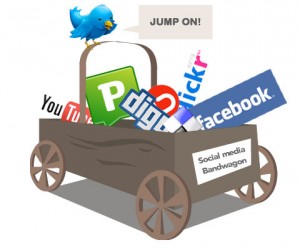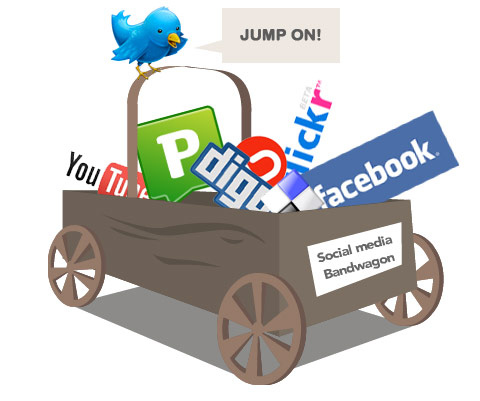[vc_row][vc_column width=”1/1″][vc_row_inner][vc_column_inner width=”1/4″][vc_column_text]

[/vc_column_text][/vc_column_inner][vc_column_inner width=”3/4″][vc_column_text]In the time-crunched, information-overloaded, do-more-with-less world we work in, maintaining the right level of social media engagement is a daunting proposition. For individuals and organizations just getting started, it can be completely overwhelming – there’s so much to do! This post strives to reduce some of the barriers to social media engagement by illustrating the importance of the “less is more” principle. It may also offer an opportunity for those with higher levels of activity to reconsider and refine their own engagement.[/vc_column_text][/vc_column_inner][/vc_row_inner][divider_line type=”divider_line”][vc_column_text]Since at least 2009, both individual professionals and organizations have felt growing pressure to increase their social media engagement. Organizations are exhorted to set up blogs, Facebook pages, Twitter accounts, YouTube and SlideShare channels, etc. – often under the threat of obsolescence if they don’t. And in addition to being invited to connect with organizations via all these channels, individuals are told that effective social media engagement is critical to their professional success and career management.
In spite of the pressure, threats, and exhortations, many professionals and organizations with low (or no) social media engagement continue to be very successful. But that doesn’t mean they should dismiss these platforms as irrelevant. The risks of not leveraging available communication channels to pursue one’s goals and objectives (aka the cost of inaction) are real, and they will continue to rise over time. Simply put, increasing social media engagement lowers risks by enhancing the ability to pursue opportunities and manage threats.
That doesn’t mean, however, that later adopters have to participate in social media in the same way and to the same degree that early adopters and enthusiasts do. In fact, many of the practices employed to date by some of social media’s biggest advocates and users have become examples of what not to do. Unbridled enthusiasm and an “anything goes” mentality are classic hallmarks of early adoption, but as things continue to mature it becomes increasingly clear that the mania isn’t sustainable. We need to strive for a better balance between quantity and quality – and for many that boils down to the principle of less is more.
This principle should certainly lower the barriers and make it easier for later adopters to increase their social media engagement, but it’s also worthy of consideration by individuals and organizations that are already actively engaged. Especially for those who are trying to extend their reach to people who are just starting to explore and experiment, it may be time to dial things back a few notches…[/vc_column_text][/vc_column][/vc_row][vc_row][vc_column width=”1/1″][vc_column_text]
Why Less Social Media Engagement is More
Not every platform makes sense. New social media platforms emerge regularly, and there’s usually a strong bandwagon effect after each launch. And of course early adopters and enthusiasts are always singing the praises of their personal favorites, exhorting others to join as well. But neither individuals nor organizations should join a social media platform just because someone says you should, or because it seems like “all the cool kids are doing it.”
It’s not all about you. For both individuals and organizations, it’s important to show your value and highlight your offerings, but too much self-focused content is another big turn-off. For individuals, it can come across as desperate, egotistical, and/or narcissistic. And organizations can sound like carnival barkers, Crazy Eddie the electronics sales guy – or worse!
Your social media engagement should be driven by your goals and objectives, as well as by the nature of the individuals/organizations with whom you want to interact.
You can cannibalize your own activity. It’s tempting to try to put a fine point on your social media engagement by having multiple Twitter handles, and/or a variety of LinkedIn groups/sub-groups, Facebook pages, Google+ pages/communities, YouTube channels, etc. Slicing engagement too finely can be very confusing to the people you’re trying to engage, however. And since many of them will pick only one of the options, they will end up concentrated in one property and/or too spread out, which impairs your effectiveness.
Trying to do too much is a recipe for failure. Both individuals and organizations who try to engage on too many platforms will find that it’s almost impossible to maintain that engagement without increased and/or dedicated resources. If they don’t increase their resource commitments, they are very likely to end up with abandoned digital properties and other digital detritus.
Develop a clear sense of what you’re going to share on each platform, as well as how often and when – and make sure your social media engagement plan can be easily maintained given available resources.
You don’t want to be part of the signal/noise problem. Many early adopters and enthusiasts (over)share – A LOT – on all kinds of platforms. The sad irony for many of them is that even though they presumably have so much to say, the more they talk the more they decrease the likelihood that people will want to listen to them (particularly when they come across as narcissistic, post banalities and old news, and/or engage in what I call cluster posting (i.e., posting several items in quick succession on a single platform)). I have digitally tuned out hundreds of people on LinkedIn, Twitter, and Facebook who talk too much and say too little – and I’m sure many others have done the same.
You look like you don’t have enough work to do. A hazard for individuals in particular is that high levels of social media engagement can be perceived as low levels of actual work engagement (even when social media engagement is part of your job).
Don’t feel pressured to be a big talker on any social media platform. Say enough to be heard, but focus more on saying things people want to listen to.
It’s not true that “anything goes.” Each platform has its own language, customs, and normative expectations. Individuals and organizations who participate without learning what sound social media engagement practices look like run a serious risk of undermining their own credibility – not just with respect to social media, but in general.
A high volume of activity isn’t acceptable on all platforms. There’s a much higher tolerance for a high volume of shares on a fast-moving platform like Twitter (up to 10 per day for most individuals and organizations). The acceptable volume of status and sharing activity on Facebook and Google+ is probably no more than half of what’s acceptable on Twitter – and on LinkedIn one individual status or company update per day is probably plenty.
Too much cross-posting can seem spammy. On the one hand, because you likely have a different network/followership on each platform, you need to cross-post to ensure your content reaches the maximum possible audience. On the other hand, if people see the same content several times in a short period of time, it’s more likely to be off-putting than enticing.
Learn and adhere to social media engagement best practices by platform. Don’t assume a one-size-fits-all approach is appropriate.
[/vc_column_text][/vc_column][/vc_row][vc_row][vc_column width=”1/1″][vc_column_text]
More Social Media Engagement Thoughts
If you have other ideas about how less social media engagement is more, I’d love to hear them!
In a follow-up post – Digital Engagement: 12 DOs and DON’Ts for Rookies – I offer additional recommendations for effective social media engagement. If you have specific questions not addressed in either post, please add a comment.[/vc_column_text][/vc_column][/vc_row]






Comments
10 responses to “Social Media Engagement: 9 Reasons Why Less is More”
Hurray for common sense. I personally think that blogging every day is ridiculous and disagree with digital pros who think you need to send your audience an email every day. Less is more!
It’s crazy isn’t it, Simone? I remember when I first started blogging the prevailing “wisdom” was to try to blog several times a day. That might work for some bloggers, but it’s terrible advice (not to mention virtually impossible) for most professional blogs, especially those with a BtoB focus. Right now, because we’re moving content from our old blog, I’m adding 2-3 posts/week, but once that’s done I think 1-2 posts/week is plenty! And we only send out an email blast once a month. I want our content to be viewed as valuable signal, not unnecessary noise!
Consistent with our “less is more” philosophy, earlier this week we deleted our accounts on Tumblr, Storify, and Instagram. It’s both a relief and a let down. We enjoyed our time on Storify, and I personally loved Tumblr, but we never got enough return on our efforts to justify our ongoing engagement.
What platforms have you or your organization had to give up on and let go of? Which ones might it be time for you to say good-bye to?